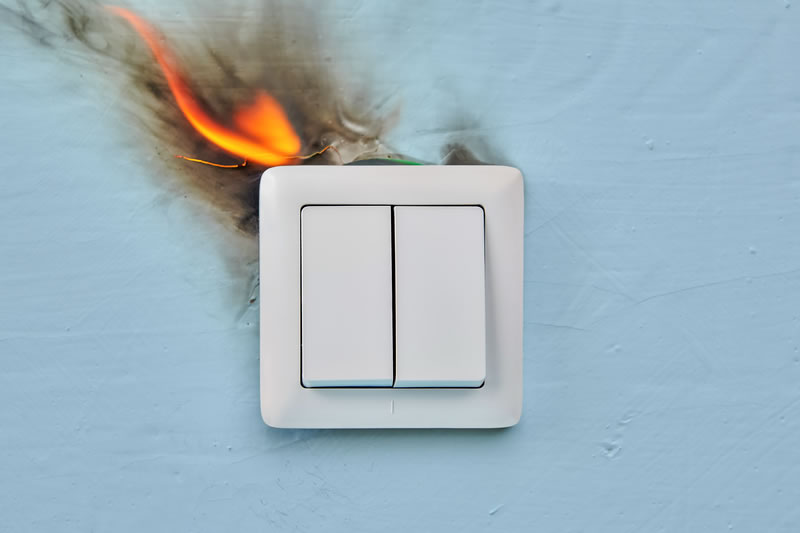
15 May It’s National Electrical Safety Month: Is Your Home Safe?
May is National Electrical Safety Month – a broad-based effort to reduce the number of injuries, fatalities, and fires related to electricity. The Electrical Safety Foundation International (ESFI), a non-profit organization dedicated exclusively to promoting electrical safety in the home, school, and workplace, honors National Electrical Safety Month each May. ESFI works to educate people about the steps that can be taken to reduce the number of electrically related fires, fatalities, injuries, and property loss.
Electricity is one of those things we don’t often think about, even as we switch on a light, plug in the coffee pot, or use the microwave. While it may not be top of mind on a daily basis, electrical safety best practices should be reviewed and considered regularly to keep your home safe. ESFI predicts that most electrocutions and home fires are preventable simply by understanding basic electrical safety principles and following safe practices.
According to the National Fire Protection Association (NFPA), 47,700 home fires in the U.S. are caused by electrical failures or malfunctions each year. These fires result in 418 deaths, 1,570 injuries, and $1.4 billion in property damage. Electrical distribution or lighting equipment (think wires, lighting, cords, and plugs) ranked first in direct property damage, and third among the major fire causes in the number of home fires, home fire deaths, and home fire injuries. Overloaded electrical circuits are also a major cause of residential fires. So, what are the tips for maintaining electrical safety at home to be sure you’re not part of these statistics? To help reduce your risk, The NFPA and ESFI both recommend that you have all electrical work done by a qualified electrician only. And this includes electrical inspections when buying or remodeling a home— the only person that should be working with electrical work is a qualified, licensed professional.
Other tips for maintaining electrical safety in your home include:
• Only use one heat-producing appliance (such as a coffee maker, toaster, space heater, etc.) plugged into a receptacle outlet at a time.
• Plug all major appliances (refrigerators, dryers, washers, stoves, air conditioners, microwave ovens, etc.) directly into a wall receptacle outlet, never an extension cord or plug strip.
• Consider installing arc-fault circuit interrupters (AFCIs) that shut off electricity when a dangerous condition occurs.
• Use ground-fault circuit interrupters (GFCIs) inside the home, as well as outdoors, to reduce the risk of shock.
• Use a light bulb with the right number of watts.
Prevention and Planning Are Key Also, in any home or workplace, you’ll want a working smoke alarm, carbon monoxide detector, and a family fire escape plan in place. Remember that smoke alarms should be installed in every bedroom, outside each sleeping area, and on every level of the home. To be sure they’re in working order, test your alarms once a month and be mindful if your alarm “chirps” or “beeps,” as that can indicate that it’s time to replace the batteries. Speaking of which, smoke alarm batteries should be replaced in accordance with the manufacturer’s instructions at least once a year. And lastly, be sure to replace the alarm as suggested by the manufacturer’s instructions, or at least every ten years.
A working smoke alarm can mean the difference between life and death in the event of a home fire. But once an alarm goes off, it’s also important to have a fire escape plan in place so everyone in the family knows what to do and where to go. Sit down as a family and come up with an agreed-upon plan. Ensure everyone knows what the fire alarm sounds like, the exits to get out of the home safely, and a good meeting spot to run to. It might sound like overkill, but you never know when you may need to act.
An emerging trend in electrical safety at home lies in the uptick in electric vehicles. Because of this rising trend, ESFI named the theme for this year’s campaign: “Electrification: E-Mobility.” The materials provided by the company explore the rapid advancement in electric vehicles and the need for safe, efficient devices that can support this increased energy demand. Do you have an electric vehicle, or are you considering purchasing one? Be sure you’re prepared for electric vehicle charging: Prepare your Home or Business for Electric Vehicles – Electrical Safety Foundation International.
As always, if you find yourself a victim of a home fire, contact us immediately. At Ohio Fire Claims, we will work with you and the insurance company to get a fair settlement. Contact us today for a free consultation or site inspection.

